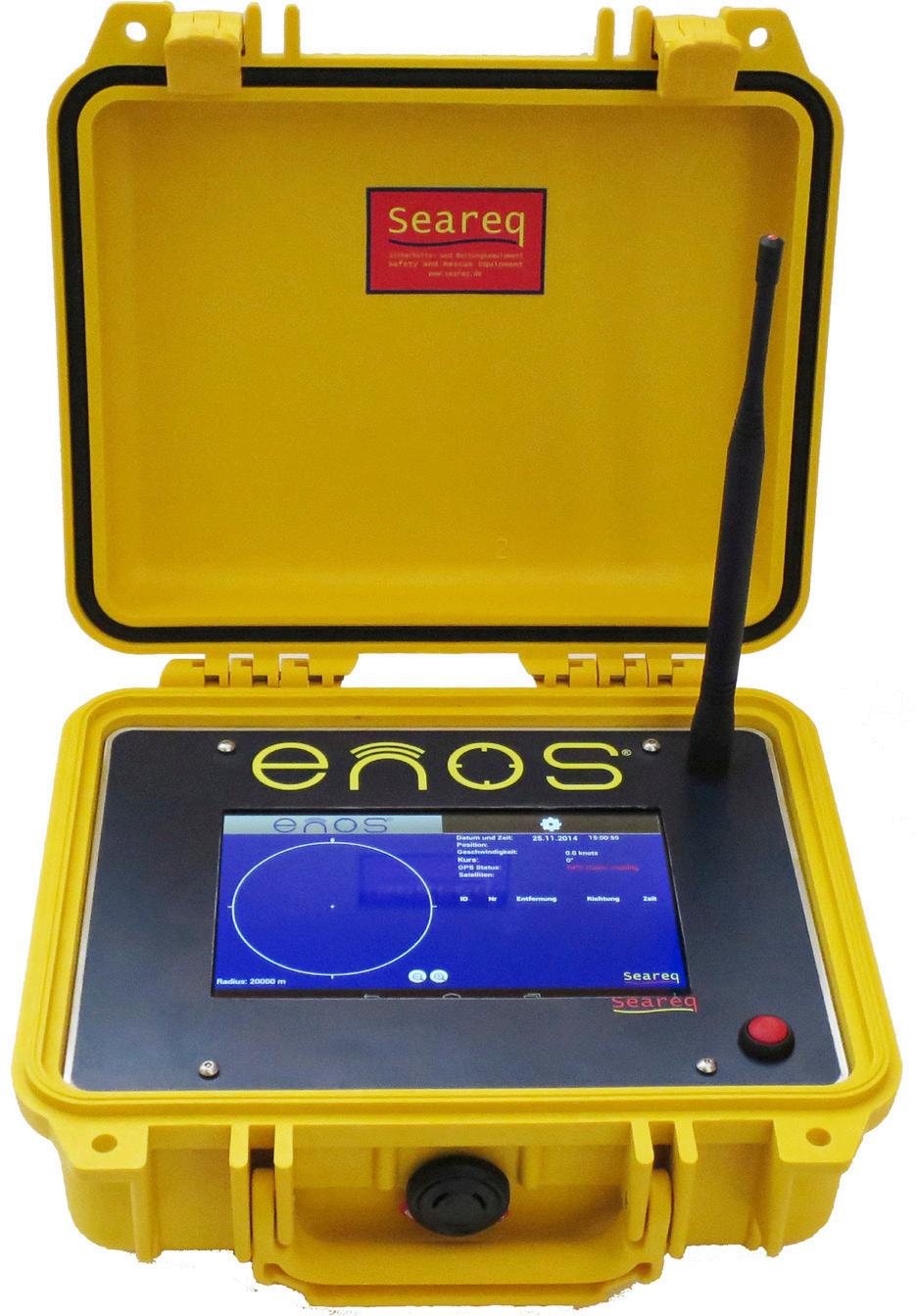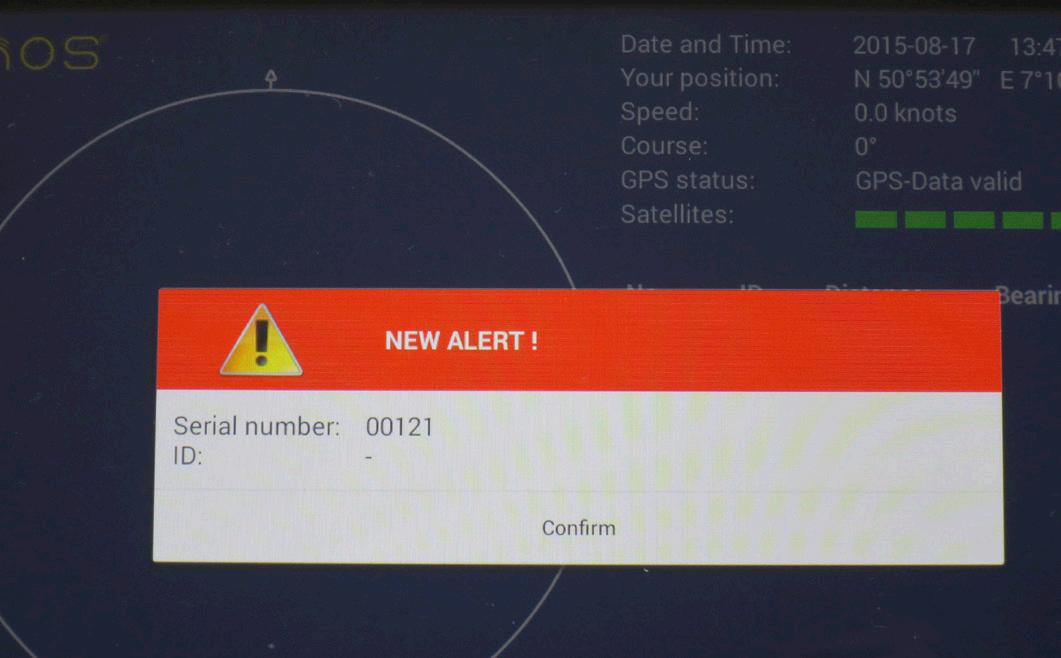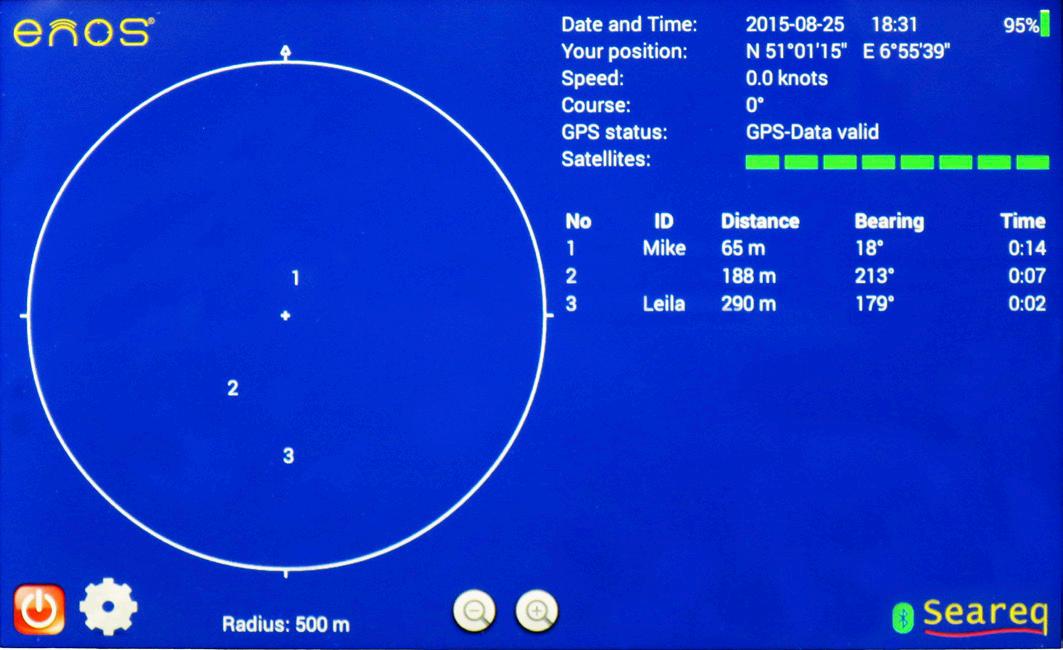
14 minute read
THE ENOS ® -SYSTEM
THE ENOS ® -SYSTEM
FEATURE CHRISTIANE LINKENBACH
Divers are just tiny drops in the ocean. So how does one find a single drop in the ocean when a diver has been swept away by currents? Searching for lost divers is one of the most difficult tasks crew on dive boats have to tackle.

ONCE UPON A TIME… In the November afternoon of 1995, in the Red Sea, at Elphinstone Reef.
The reef is famous for its beautiful corals and sharks as well as its (strong) currents. On that day, three divers were swept away at the start of their dive towards the south where no further dive spots exist, in an area of more than a hundred kilometres. This part of the region is not frequented by dive boats.
Their absence was only noticed after more than an hour, when the last divers surfaced.
A search operation was promptly and strategically initiated: despite the short surface interval, the guide jumped into the water to perform a search and recovery dive, the inflatable vessel headed along the reef where the divers were last located from their descent and the mothership cruised in open waters around the “Elphinstone Reef”. The crew and 16 divers continued to observe the surface until their eyes burned.

Unsuccessful – the three divers remained lost.
Finally, the captain had to call a stop to the search operation. The sun had already set and darkness had now spread. In order to not endanger the lives of the other divers onboard, the captain looked for a safe place to anchor in the shallow waters.
In the 90s, it was impossible to initiate a search and rescue operation. Liveaboards were small back then and only a few boats were able to get to the far to reach reefs. There were no coastguard stations along the stretch of coast to ask for help. Mobiles weren’t properly established and their use was especially limited at sea.
There was no one to inform and send an SOS to about the 3 missing divers. It was left to the boat and its passengers onboard.
54 HOURS DRIFT – 100 KILOMETRES Two days later, 100 kilometres in the south of “Elphinstone Reef”.
Another safari boat headed straight to the dive spots in the very south, close to the Egyptian-Sudanese border. Still in deep waters, with no reefs around in their current location, the captain carried on in high speeds to get to their destination. No other vessels were seen. The captain suddenly paused as he spotted something on the surface with his trained eyes. One of his crew focused on the same point. The two professionals immediately recognised it was a human being drifting on the water’s surface.
A VERY LAST MINUTE RESCUE Just a few minutes later, the crew helps a completely exhausted and dehydrated diver climb aboard. His face was sunburnt, his lips were chapped. When they carefully took his wet suit off, he had open wounds visible on his arms and legs.
Despite his pain, he urged the captain to carry on and look for his two buddies who were hopefully also still drifting.
The crew couldn’t believe this diver had drifted from Elphinstone Reef, a hundred kilometres away –together with two buddies!
WHERE ARE THEY? The diver reported that after having drifted for more than two days in the Red Sea, day and night, his buddies had decided to end it by drinking salt water. The two divers swam out to the open sea to spare their buddy from having to watch them die.

Now the taskwas to find them both as quicklyas possible, with the chance they may still be alive.
They were found, still alive, but in the same poor physical condition as their buddy. They survived and thankfully, their physical wounds have healed completely.
NO EXCEPTION Although this incident was an absolutely horrendous ordeal, it caused positive interacts: danger caused by currents was finallyrecognised by divers!
The fact that divers were lost due to currents, and a search and rescue mission had to be performed is nothing new. This has existed for decades in the diving industry, but (almost) no one was reporting these accidents. Not only were some of the search operations unsuccessful causing uncertainty to what really happened to the missing divers, but the tourism industry doesn’t like to admit to fatalities, especially during “the busiest weeks of the year”.
The international dive media however, covered the story for months, reporting extensively about the three divers in the Red Sea. Then, the movie, ‘Open Water’, about the story of two divers who were forgotten at the Great Barrier Reef was launched in 2005.
Worldwide divers were concerned. One of these concerned divers was Karl Hansmann, a graduated engineer in electro-technologies and informatics (CMAS “Gold” cer tified diver), who dived the Red Sea many times. He not only knows Elphinstone Reef, but he also knows the dive centre, the boat, the captain, and the crew because he spent several months in the Red Sea to check and overwork the electricity and electronics of all the dive boats in this fleet.
He spoke a lot about that incident with the staff of the dive centre, as well as with the divers who were onboard the rescue boat, and their eye-witness repor ts horrified Karl. Although he knew how dangerous currents can be, he could not believe how quickly a diver vanishes at the surface – in spite of the equipment and an SMB.
It would take some time before he would find the solution.
VISIONARY Approximately one and a half years later, Karl got the visionary idea to locate divers by GPS.
What seems to be “an old hat trick” today, was almost revolutionary in the late 90s because GPS had only recently been allowed for civil use and the first navigation systems had only just entered the market.
“All of sudden, I clearly saw the solution”, he says. “If the diver relays his GPS position to the boat, the crew knows where to collect the diver up from in the water.”
Sounds simple. He was convinced that such rescue systems already existed on the market, but nevertheless, he began his research. He investigated sea emergency systems and sea emergency frequencies meticulously, the principles of functioning, the demands – to come to the result, that none of the existing devices fulfil the requirements of the diving industry. [See the article in Divers for the Environment’s September 2019 issue, pages 50-59 – What You Know Could Save Your Life.]

ENOS-Receiver Tablet Screen.

ENOS-Receiver Integrated Touchscreen.
LIFESAVING FOR SEAFARERS – BUT NOT EFFICIENT FOR DIVERS “Merchant marine rescue systems are supported by SAR which can be connected via varying radio frequencies”, he explains. “But this requires special equipment onboard to send and to receive these radio frequencies. This is expensive and a radio license is necessary – not to speak about the fact that these devices can’t be installed on many dive boats,” and he draws the attention to the different kinds of boats used at dive centres: from luxury liveaboards to inflatable vessels, rustic fisher boats, country-specific boats such as the Maldivian Dohnies,Philippine Bangkas… Furthermore it has to be emphasised that almost no diving instructors are radio cer tified to use these devices correctly. “It was totally clear to me that I wasn’t moving forward in this way,” he sums up.
“Additionally, one question came to me each time I imagined a diver surfacing just a little too far away from their boat. Why would I call SAR who is thousands of kilometres away, if my boat is only a few hundred metres away from me? It would be so much faster to rescue the diver with their own boat and their own crew ifthey could be the ones to call!”
SOUNDS LOGICAL AND CONVINCING Together with a graduated engineer of communication technology colleague, Karl realised his idea and turned it into a prototype. They developed a system consisting of two units, a receiver and transmitters (beacons), in which both are GPS supported. In case of emergencies, the beacon relays its GPS position directly to the receiver onboard the dive boat.
THE 1 st AUTONOMOUS RESCUE SYSTEM FOR DIVERS WAS BORN At the beginning, they talked about the “electronic rescue and locating system” (in German “Elektronischen Notruf und OrtungsSystem”). This is a typically precise and objective formulation to engineers. In time, they branded it ENOS, consisting of the first letters of the German term. Meanwhile, the “ENOS ® - System” is a registered trade mark and has been in worldwide operation since 2004.
It’s remarkable that the device still works with the same function it was developed in. Only the shape of the beacons have changed; to a smaller size – and it became cheaper, much to the delight of the entrepreneurs.
INDEPENDENT AND SELF-CONTAINED This is the sequence of events of a typical rescue operation with the ENOS ® -System:
1. The ENOS ® -Receiver is placed onboard and has been switched on prior the dive. It determines its GPS position and is now ready to receive and to evaluate alerts from the ENOS ® -Beacons.
2. Every diver gets an ENOS ® -Beacon which can easily be attached to the equipment. The Beacon only weighs 220 grammes, (including pouch, rope and snap hook) and is pressure proofed up to 100 metres/330 feet. It is only activated in case of emergencies.
3. If a diver surfaces too far away from the boat, he just has to switch on the beacon by turning the “red foot” 180°. This is very easy to handle even under high stress and with wet cold fingers or thick gloves.
4. Just 5 seconds later, a 1st alert is received onboard: A red warning arises on the display of the receiver and a high-frequency sound informs the crew about the case of emergency. Both, the red window, as well as the audible alert, remains until the alert is confirmed by someone in the crew.
5. Now the crew is informed and searches the surface. If the diver is still visible, the rescue can be initiated promptly, just a few seconds after the beacon was activated. If the diver is not visible (because of dawn, sun reflections, long distance, high swell, etc.) the crew just needs to wait until the position of the diver is displayed on the screen of the receiver.
6. In average, this takes 1 to 1.5 minutes. Immediately after the 1st alert was relayed to the dive boat, the ENOS ®-Beacon determines its own GPS position. As soon as the GPS position is identified, the beacon then sends the GPS data directly to the ENOS ®-Receiver. Both, the determined GPS position and forwarding this GPS data to the ENOS ®-Receiver are performed automatically by the ENOS ®-Beacon; no further action is required by the diver other than switching the ENOS ®-Beacon on. That’s why the ENOS ®-Beacon provides only one easy to handle switch instead of several buttons which confuse divers under stress, even if they are in different colours or shapes.
7. Using its own GPS position and the received GPS data from the ENOS ®-Beacon, the ENOS ®-Receiver then evaluates the precise distance and bearing from the boat to the drifting divers. This lifesaving information is visualised as an easily understandable graph on the receiver’s screen.

ENOS-Functioning Principle.
It’s no wonder crew on ENOS ®-Boats never have to struggle searching for missing divers, they always see them clearly on the display of the ENOS ®-Receiver. If several divers are swept away and call for help at the same time, the ENOS ®-Receiver is able to receive, evaluate and show all alerts simultaneously. Even in this exceptional situation, the crew is able to see where the divers are at with just a glance.
The receiving range of the ENOS ®-System depends on the height of the radio receiving antenna, as with any device supported by radio frequency. To increase performance and safety, and to find an ideal solution forany kind of boat, the ENOS ®-Receiver is available in several varieties. On request, an external radio receiving antenna can be connected to the receiver to receive alerts from distances up to 10 km/5.6 NM.

NOS-Display Alerts.
UNIQUE FEATURES Reporters should be very careful with exuberant terms such as “unique features” to avoid false advertising and marketing language; particularly when they are writing product reports. Nevertheless, in context to the ENOS ®-System, it’s reasonable due to the fact that there are several features which are not found on any other rescue system – neither for sailors/boaters, nor for divers: the beacon and receiver are very easy to handle and clear to understand.
The crew is alerted within seconds and the rescue is often initiated in the first minute(s)! Since the ENOS ®-System was launched in 2004, no rescue has taken longer than 17 minutes despite divers being swept 3 km/1.7 NM away!
The portable ENOS ®-Receiver is recommended for dive centres frequently using different boats –or when the rescue is operated by inflatable vessels. The high-tech electronics are protected in a splash-proof (Peli) case which can also be used in a dinghy, and the ENOS ®-Display guides directly to the divers in need. No other maritime electronic receiving device can be carried in an inflatable vessel!

NOS-Display Alerts.
The ENOS ® -Beacon transmits an update every 15 seconds of its position (for comparison: the man-over-board-beacons relay an update every 3-5 minutes)! This is high value information for the captain, specifically if he has to choose another direction by having to go around a reef to get to the diver.
Despite the very short updates, the ENOS ® - Beacon has an operational time of 170 hours = 1 week! World record. No one has to be concerned about the performance of the batteries when a beacon was used several times during a diving safari because on average, an ENOS ®-Rescue takes 7 minutes. Furthermore, it’s clearly indicated when the batteries need to be changed.
The ENOS ®-Beacon is powered by 2 customary Lithium AAA batteries which are available all over the world and which can be changed by the diving instructors themselves (no need to ship the beacons to the manufacturer).

The system is very robust and withstands the harsh conditions of a dive boat. The ENOS ® - Beacon’s antennas are inside the housing giving them maximum protection against damage. It’s not just clever, but really unique in the world of sea emergency beacons. There have been no reports of a broken antenna in an ENOS ® - Beacon since its inception.
The radio frequency of the ENOS ®-System is license free, and free of charge. A radio cer tificate (“SRC“, Shor t Range Cer tificate“) is not required and has no monthly fees or expenses after use.
From the very first development, it was clear to Karl that his product must be autarkic. It had to be independent of SAR which is located along the coast line and not available in the remote areas where liveaboards cruise, and independent of maritime radio and navigation devices which are not available on all dive boats.
Being robust and pressurised up to 100 metres/330 feet were the 2 easiest conditions to fulfil. Taking all of this into consideration, it is no wonder that the ENOS ®-System reflects positivity with divers when they see the slogan, “ENOS ® Onboard”. Tour operators and travel agents have attested that ENOS ® - Boats are more readily booked which is the reason every entrepreneur has reached the break-even earlier than expected – regardless of whether it is in the North Sea, the Red Sea, the Maldives, Indonesia, South Africa…

FROM PASSION TO PROFESSION Karl founded his company Seareq, Safety and Rescue Equipment in 2003 which is still the manufacturer of the ENOS ®-System. Since then, many, many systems have been delivered somewhere, and thousands of Beacons are in worldwide application and have rescued many, many divers’ lives.
Over time, the ENOS ®-System gained a “little brother”, the Man-Over-Board-OperatingSystem, MOBOS ® , specifically developed for boaters, wind and kitesurfers.
It is based on the same reliable and successful technology as ENOS ®, with the same robust and unique characteristics, but provides a beacon with a switch which is released automatically by the self-inflation of the automatic lifejacket in case of emergency.










